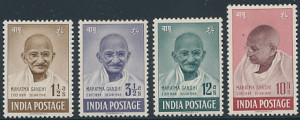One of the most fascinating collecting areas is India and States. Part British Colony, part Third World nation, part of the developing world, the philately of India has much to offer. And, an added bonus for Americans is that most of the good philatelic literature and writing about this area is in English.
Indian philately breaks down into five main areas with numerous additional sub specialties. First there is the period of British occupation-the stamps from 1860 to 1948. These are the main general issues for India and contain many interesting Victoria issues as well as the better long Edward and George definitive sets that British Commonwealth philately is known for. The early issues are interesting and difficult and the Officials are fascinating. The Convention States are the second main aspect of Indian philately. They are stamps issued for use in semi-autonomous States that were allied to the British government. They are hard to find and fit in well with any British collection. Third, there are the Native States, usually primitive stamps issued by local, largely independent regions in India. These are some of the most interesting stamps in all of philately. They are difficult to find and even $1 and $2 stamps can be elusive. Fourth, there is independent India-the post 1948 issues, which offer the collecting interest of any modern country. They are colorful and replete with Indian culture and history. And last, there are Indian stamps used abroad and in areas that are not now part of India. As the major political and military center of the eastern British Empire, Indian stamps were used as far as Aden on the west to Malaysia on the east. Further, what is now Pakistan and Burma were part of the Indian Empire so Indian stamps were used there as well.
As the Indian economy continues its miracle development, expect Indian stamps to continue to gain popularity. I think the current prices of Indian stamps will look very cheap in just a few years.
